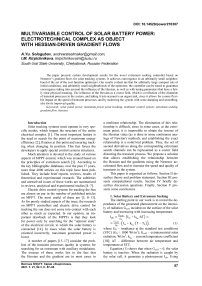Multivariable control of solar battery power: electrotechnical complex as object with hessian-driven gradient flows
Автор: Sologubov A.Yu., Kirpichnikova I.M.
Журнал: Вестник Южно-Уральского государственного университета. Серия: Энергетика @vestnik-susu-power
Рубрика: Альтернативные источники энергии
Статья в выпуске: 3 т.21, 2021 года.
Бесплатный доступ
The paper presents certain development results for the novel extremum seeking controller based on Nesterov’s gradient flows for solar tracking systems. It achieves convergence to an arbitrarily small neighborhood of the set of the cost function optimizers. Our results evident ate that for arbitrarily large compact sets of initial conditions, and arbitrarily small neighborhoods of the optimizer, the controller can be tuned to guarantee convergence taking into account the influence of the Hessian, as well as with tuning parameters that have a fairly clear physical meaning. The influence of the Hessian as a vector field, which is a reflection of the distortion of transient processes in the system, and taking it into account is an urgent task, since it allows for a more flexible impact on the speed of transient processes, and by endowing the system with some damping and smoothing, also for its improved quality.
Solar panel power, maximum power point tracking, nonlinear control system, extremum seeking, gradient flow, hessian
Короткий адрес: https://sciup.org/147236640
IDR: 147236640 | УДК: 621.3.078.3 | DOI: 10.14529/power210307
Список литературы Multivariable control of solar battery power: electrotechnical complex as object with hessian-driven gradient flows
- Kirpichnikova I.M., Sologubov A.Y. Multivariable Control of Solar Battery Power by Extremum Seeking: Starting from Linear Analysis. Machines, 2019, vol. 7, no. 4, pp. 64. DOI: 10.3390/machines7040064
- Demenkova T.A., Korzhova O.A., Phinenko A.A. Modelling of algorithms for solar panels control systems. Procedia - Procedia Computer Science. The Author(s), 2017, vol. 103, no. October 2016, pp. 589-596. DOI: 10.1016/j.procs.2017.01.072
- Pakkiraiah B., Sukumar G.D. Research Survey on Various MPPT Performance Issues to Improve the Solar PV System Efficiency, 2016, vol. 2016. DOI: 10.1155/2016/8012432
- Ram J.P., Babu T.S., Rajasekar N. A comprehensive review on solar PV maximum power point tracking techniques. Renewable and Sustainable Energy Reviews. Elsevier, 2017, vol. 67, pp. 826-847. DOI: 10.1016/j.rser.2016.09.076
- Sumathi V. et al. Solar tracking methods to maximize PV system output - A review of the methods adopted in recent decade. Renewable and Sustainable Energy Reviews. Elsevier, 2017, vol. 74, no. February 2016, pp. 130-138. DOI: 10.1016/j.rser.2017.02.013
- Dogga R., Pathak M.K. Recent trends in solar PV inverter topologies. Solar Energy. Elsevier, 2019, vol. 183, no. February, pp. 57-73. DOI: 10.1016/j.solener.2019.02.065
- Ahmad R., Murtaza A.F., Ahmed H. Power tracking techniques for efficient operation of photovoltaic array in solar applications - A review. Renewable and Sustainable Energy Reviews. Elsevier Ltd, 2019, vol. 101, no. November 2017, pp. 82-102. DOI: 10.1016/j.rser.2018.10.015
- Tan C.F., Khalil S.N. Fuzzy rule-based model for optimum orientation of solar panels using satellite image processing Fuzzy rule-based model for optimum orientation of solar panels using satellite image processing. Journal of Physics: Conference Series, 2017.
- Ya'u M.J. A Review on solar tracking systems and their classifications. Journal of Energy, Environmental & Chemical Engineering, 2017, vol. 2, no. 3, pp. 46-50.
- Hamid A.R. et al. A review on solar tracking system. Proceeding National Innovation and Invention Competition Through Exhibition (iCompEx'17), 2017.
- Al-Rousan N., Isa N.A.M., Desa M.K.M. Advances in solar photovoltaic tracking systems: A review. Renewable and Sustainable Energy Reviews. Elsevier Ltd, 2018, vol. 82, no. January, pp. 2548-2569. DOI: 10.1016/j.rser.2017.09.077
- Singh R. et al. An imperative role of sun trackers in photovoltaic technology: A review. Renewable and Sustainable Energy Reviews, 2018, vol. 82, pp. 3263-3278. DOI: 10.1016/j.rser.2017.10.018
- Hafez A.Z., Yousef A.M., Harag N.M. Solar tracking systems: Technologies and trackers drive types -A review. Renewable and Sustainable Energy Reviews. Elsevier Ltd, 2018, vol. 91, no. March, pp. 754-782. DOI: 10.1016/j.rser.2018.03.094
- Esram T., Chapman P.L. Comparison of Photovoltaic Array Maximum Power Point Tracking Techniques, 2007, vol. 22, no. 2, pp. 439-449. DOI: 10.1109/tec.2006.874230
- Trollberg O., Jacobsen E.W. On the Convergence Rate of Extremum Seeking Control. 2014 European Control Conference, ECC 2014, 2014, pp. 2115-2120. DOI: 10.1109/ecc.2014.6862265
- Ghaffari A., Krstic M., Nesic D. Multivariable Newton-based extremum seeking. Automatica. Elsevier Ltd, 2012, vol. 48, no. 8, pp. 1759-1767. DOI: 10.1016/j.automatica.2012.05.059
- Poveda J.I., Krstic M. Fixed-Time Extremum Seeking, 2019, no. 1, pp. 2838-2843.
- Bellia H. A detailed modeling of photovoltaic module using MATLAB. Nriag journal of astronomy and geophysics. National Research Institute of Astronomy and Geophysics, 2014. DOI: 10.1016/j.nrjag.2014.04.001
- Bhatt P. et al. Optoelectronic modelling of perovskite solar cells under humid conditions and their correlation with power losses to quantify material degradation. Organic Electronics, 2016, vol. 39, pp. 258-266. DOI: 10.1016/j.orgel.2016.10.015
- Cubas J., Pindado S., Victoria M. On the analytical approach for modeling photovoltaic systems behavior. Journal of Power Sources, 2014, vol. 247, pp. 467-474. DOI: 10.1016/j.jpowsour.2013.09.008
- Notton G. et al. Modelling of a double-glass photovoltaic module using finite differences. Applied Thermal Engineering, 2005, vol. 25, pp. 2854-2877. DOI: 10.1016/j.applthermaleng.2005.02.008
- Wu H. A Maximum Power Point Detection Method for Photovoltaic Module Based on Lambert W Function Based on Lambert W Function. Mathematical Problems in Engineering, 2018, vol. 2018, p. 8. DOI: 10.1155/2018/8082960
- King D.L., Boyson W.E., Kratochvil J.A. Photovoltaic array performance model. Thesis for: PhD, 2004.
- Khatib T., Elmenreich W. Modeling of Photovoltaic systems Using MATLAB. Hoboken, New Jersey, 2016. 242 p.
- Reda I., Andreas A. Solar Position Algorithm for Solar Radiation Applications (Revised). NREL/TP-560-34302. Golden (Colorado), 2008, no. January. 56 p. DOI: 10.2172/15003974
- Johnson J. et al. Creating dynamic equivalent PV circuit models with impedance spectroscopy for arc fault modeling. 2011 37th IEEE Photovoltaic Specialists Conference, 2011, pp. 2328-2333. DOI: 10.1109/pvsc.2011.6186419
- Sologubov A.Y., Kirpichnikova I.M. Calculation of the Parameters of the Daily Movement of the Sun. Contour Maps of Kinematic Parameters. 2019 International Conference on Industrial Engineering, Applications and Manufacturing (ICIEAM), 2019, pp. 1-6. DOI: 10.1109/icieam.2019.8742935


